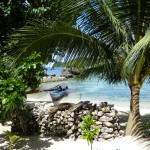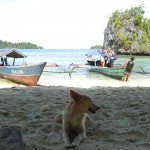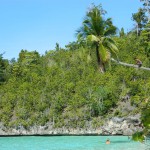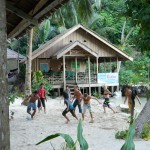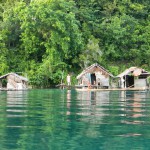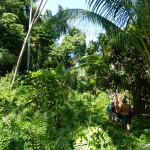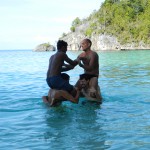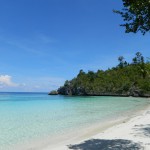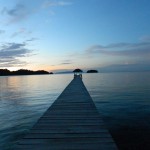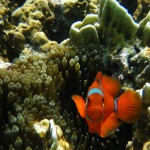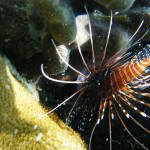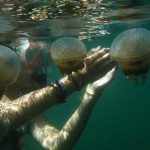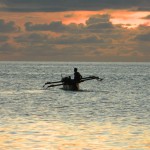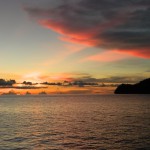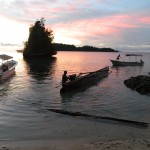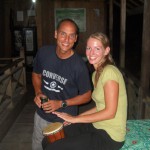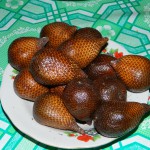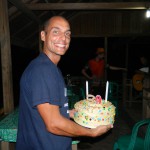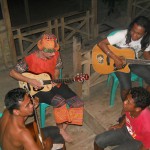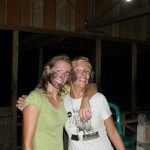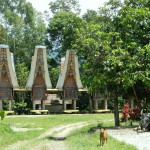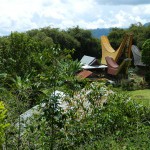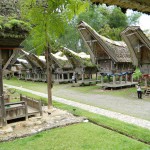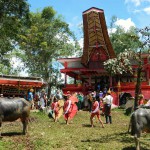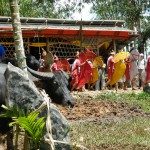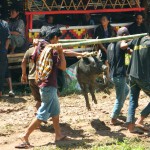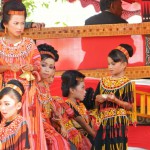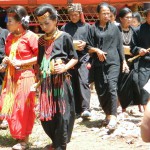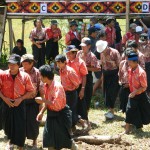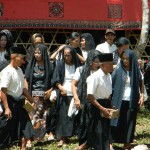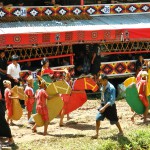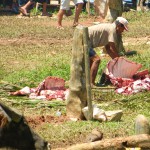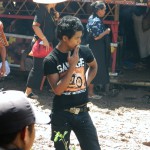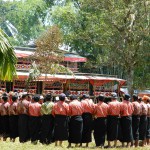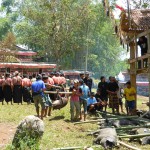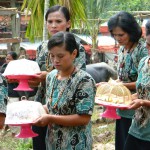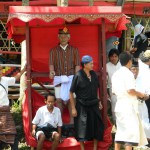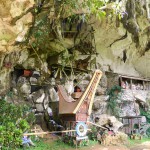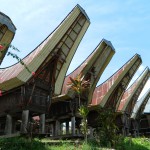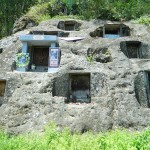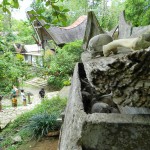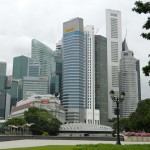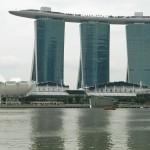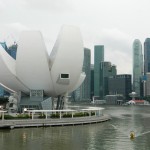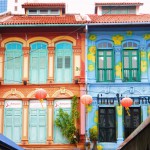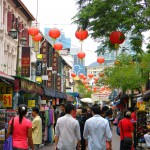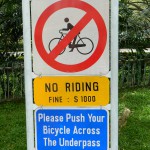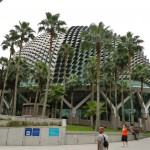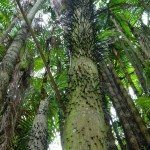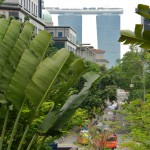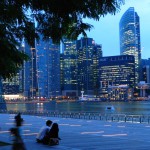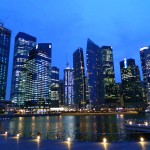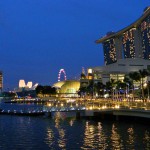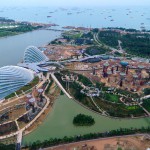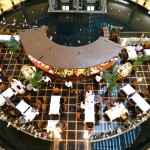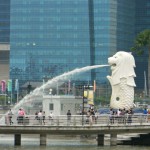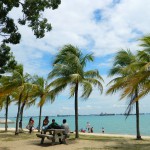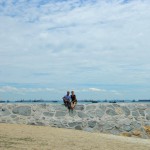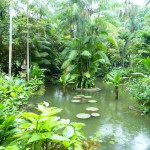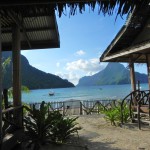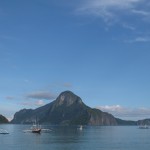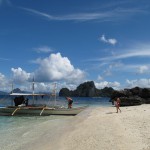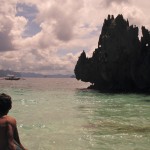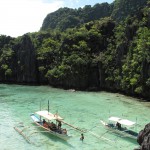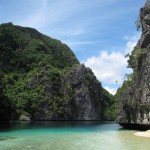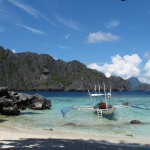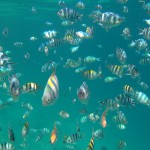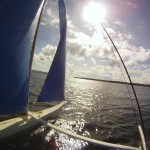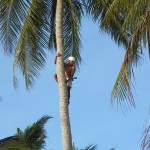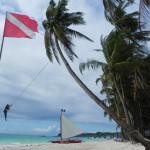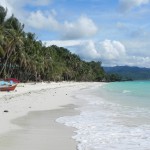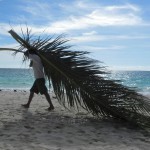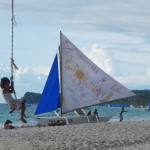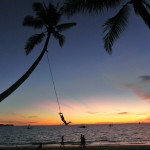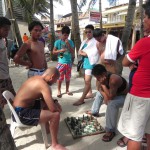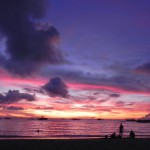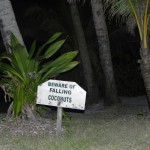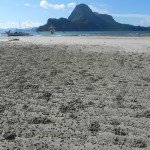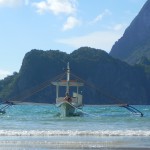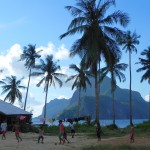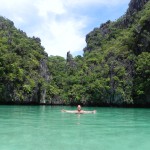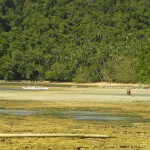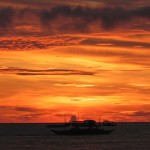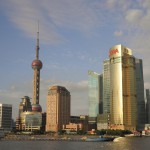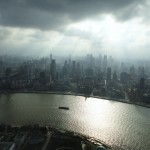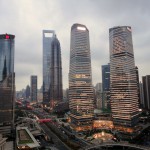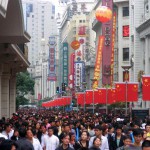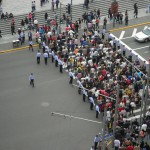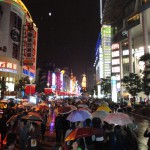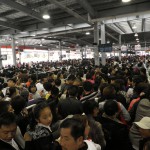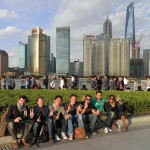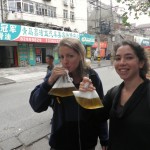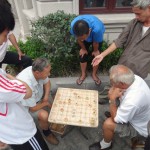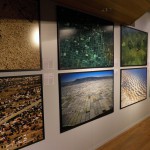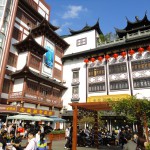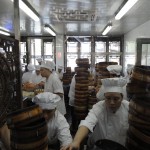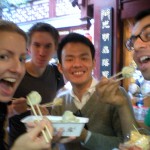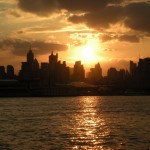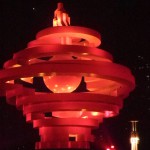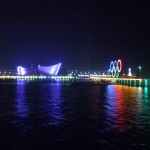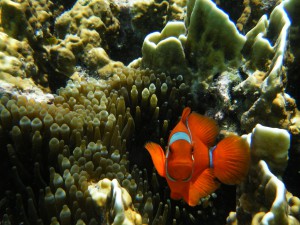 After Tana Toraja we headed – interrupted by an unexciting stop in Central Sulawesi’s Tentena – towards the Togian Islands. We had a little problem when we realized we were too short of cash for a longer stint on the islands and there was no Visa-capable ATM in a 15-hour-journey perimeter around Ampana, but thanks to Mastercard and 20 euros (!) fee to get 200 euros worth of rupiahs out of the ATM we were afloat again. Why are the banks in crisis? Anyway.
After Tana Toraja we headed – interrupted by an unexciting stop in Central Sulawesi’s Tentena – towards the Togian Islands. We had a little problem when we realized we were too short of cash for a longer stint on the islands and there was no Visa-capable ATM in a 15-hour-journey perimeter around Ampana, but thanks to Mastercard and 20 euros (!) fee to get 200 euros worth of rupiahs out of the ATM we were afloat again. Why are the banks in crisis? Anyway.
We decided to go to Kadidiri Island and spent more than a week with the Lestari family. We had a terrific time, played loads of chess and guitar, went for fantastic snorkelling and swimming, visited beaches that were taken straight out of the dream holiday catalogue, and drank our share of arak, the local firewater.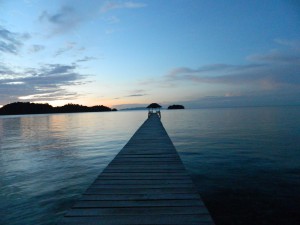
Our whole stay was crowned with my birthday party on the last evening, which surprisingly ended in an epic battle of smearing and throwing parts of the delicious birthday cake at each other’s faces  That party and the time on Kadidiri as well as the great people we met will stay in our memories – hope to see you guys again.
That party and the time on Kadidiri as well as the great people we met will stay in our memories – hope to see you guys again.
-
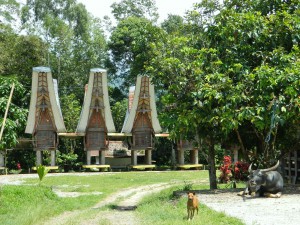 Tana Toraja is a mountainous region of South Sulawesi, famous for extraordinary boat-shaped roofs, burial sites carved into rocky cliffs and elaborate funeral rites. Although 90% of the Indonesian population is Muslim, the Torajans are mostly Christian with animist beliefs that are recognized by the government as the “Way of the Ancestors”.
Tana Toraja is a mountainous region of South Sulawesi, famous for extraordinary boat-shaped roofs, burial sites carved into rocky cliffs and elaborate funeral rites. Although 90% of the Indonesian population is Muslim, the Torajans are mostly Christian with animist beliefs that are recognized by the government as the “Way of the Ancestors”.
The funeral ceremonies are a tremendously expensive social event, attended by hundreds of people and lasting several days. The richer the deceased, the more expensive the death feast. It includes dances, chants, rites and slaughtering of animals. The Torajans believe that the persons who died need water buffaloes to make their journey into Puya (the afterlife) and that they will be quicker if they have many buffaloes.
We attended one of the bigge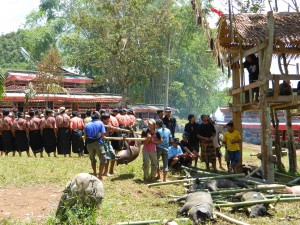 r funerals. Men, women and children performed colourful dances. The guests arrived, bringing along dozens of pigs which were screaming horribly, anticipating their fate, and chopping noises were always present.
r funerals. Men, women and children performed colourful dances. The guests arrived, bringing along dozens of pigs which were screaming horribly, anticipating their fate, and chopping noises were always present.
The funeral is often held months or years after death, so that the deceased’s family has time to raise the respective funds. The soul is thought to linger around the village until the ceremony is completed. We heard of one case waiting for 35 years for the funeral. The Torajans do not consider death as an abrupt event, but as a gradual process towards the “land of souls”. In the meantime, the body is conserved with formalin and kept wrapped in layers of cloth in the family’s house, sometimes even in the bedroom.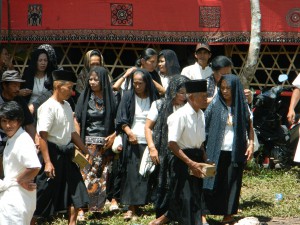
There are several ways to lay the deceased to rest. So for example the rocky cliff and caves near Kete Kesu are full of graves: Decayed and sometimes open wooden coffins full of skulls and bones suspended or fallen between the rocks or lying in caves. Wealthy families place a wood-carved effigy called Tau Tau, resembling closely the person who died, next to the grave.
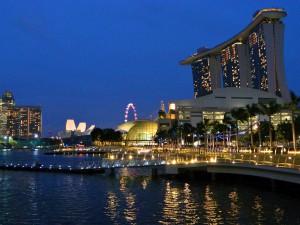 The city of Singapore, situated a few degrees north of the Equator, was a stopover for us between the Philippines and Indonesia. Especially the cultural diversity immediately caught our attention. Arabs, Indians, Malays, Chinese and many other cultures live here in peaceful co-existence, providing for a wealth of variety, for instance when it comes to food and clothes.
The city of Singapore, situated a few degrees north of the Equator, was a stopover for us between the Philippines and Indonesia. Especially the cultural diversity immediately caught our attention. Arabs, Indians, Malays, Chinese and many other cultures live here in peaceful co-existence, providing for a wealth of variety, for instance when it comes to food and clothes.
But Singapore’s wealth is more than its cultures. The city state is immensly rich, holding a place among the top five countries in terms of GDP per head, and it shows. Ferraris, Lamborghinis, Bentleys, Maseratis wherever you look, and again, as almost everywhere now in Asian cities, glittering shopping malls in abundance. More land is reclaimed from the sea, and more hotels and malls are built. We were impressed with the Marina Bay Sands hotel with its ship-shaped top and the spectacular views from there.
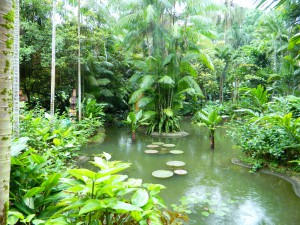 The former British colony is famous for its strict laws and severe punishments, and indeed advertised fines for what sometimes is a minor offense are hefty. However, probably as a result, the city is very safe and clean.
The former British colony is famous for its strict laws and severe punishments, and indeed advertised fines for what sometimes is a minor offense are hefty. However, probably as a result, the city is very safe and clean.
We strolled around town, went to the cinema and to the beach, played drums, visited a Dalí exhibition in the ArtScience Museum, had the most expensive thali ever in an Indian restaurant, and in general prepared for our onward journey. With our snorkelling gear in the backpack we moved on to Indonesia.
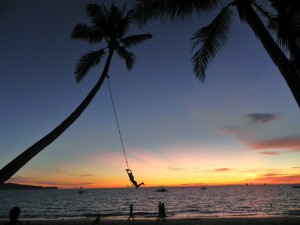 After our trips from Beijing to Shanghai, and respectively, after snow in Mongolia, the beaches on the Philippines presented a very nice change. There’s not much to tell about the weeks we spent there, lots of sunsets, San Miguel beer, pork menudo, and hanging about at the beach or the Red Pirates bar.
After our trips from Beijing to Shanghai, and respectively, after snow in Mongolia, the beaches on the Philippines presented a very nice change. There’s not much to tell about the weeks we spent there, lots of sunsets, San Miguel beer, pork menudo, and hanging about at the beach or the Red Pirates bar.
While Boracay’s White Beach was great to stay at and swim, El Nido on Palawan island had us take island hopping tours to enjoy some great snorkelling. Unfortunately, in one of the lagoons the attack of a biting fish (certainly as big as a shark) made us drown our camera, which we later replaced in Singapore.
We found the people on the Philippines very friendly and welcoming, and except for a truly tropical storm beginning of October, the weather was just fine. The snorkelling and the beautiful islands made us hungry for more, and we decided to move on to Indonesia and spend a great deal of time on the Maluku Islands. But first we had to put in a stopover in Singapore to get a 60-day visa.
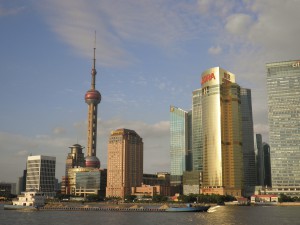 My penultimate stop in China was Qingdao, a nice and enjoyable seaside city. Major seaport in China, Qingdao hosted the Olympic Sailing competitions in 2008 and was in the hands of Germans for decades, so it still retains many buildings with a German architectural style. I strolled along the new seafront promenade and felt strange to find myself in a “Marktstrasse” with German shops and inscriptions. Qingdao is also the home of China’s second largest Tsingtao-brewery. The Germans did a good job here! As a result, beer is available everywhere and even sold in Qingdao-style: from kegs, in plastic bags, to be drunk through straws! With newly met friends, we jumped on the springy platform of a dance floor and continued our road together to Shanghai.
My penultimate stop in China was Qingdao, a nice and enjoyable seaside city. Major seaport in China, Qingdao hosted the Olympic Sailing competitions in 2008 and was in the hands of Germans for decades, so it still retains many buildings with a German architectural style. I strolled along the new seafront promenade and felt strange to find myself in a “Marktstrasse” with German shops and inscriptions. Qingdao is also the home of China’s second largest Tsingtao-brewery. The Germans did a good job here! As a result, beer is available everywhere and even sold in Qingdao-style: from kegs, in plastic bags, to be drunk through straws! With newly met friends, we jumped on the springy platform of a dance floor and continued our road together to Shanghai.
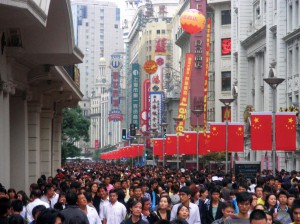 The largest city by population in China was even more crowded during the Chinese National Holiday. Possibly the biggest crowds we have ever seen couldn’t stop us from taking a walk alongside The Bund, at the banks of the Huangpu River. We fought our way to see the Pudong skyline, Shanghai’s financial and commercial hub. It was even more impressive by night, all lit up. My eyes were quite satisfied having seen the panoramic view from the Oriental Pearl Tower – it makes you feel so tiny and unimportant! – and the beautiful “Above the Earth” photography exhibition. But then it was time to make my stomach happy – with excellent crab-meat-filled juicy dumplings!
The largest city by population in China was even more crowded during the Chinese National Holiday. Possibly the biggest crowds we have ever seen couldn’t stop us from taking a walk alongside The Bund, at the banks of the Huangpu River. We fought our way to see the Pudong skyline, Shanghai’s financial and commercial hub. It was even more impressive by night, all lit up. My eyes were quite satisfied having seen the panoramic view from the Oriental Pearl Tower – it makes you feel so tiny and unimportant! – and the beautiful “Above the Earth” photography exhibition. But then it was time to make my stomach happy – with excellent crab-meat-filled juicy dumplings!
 After Tana Toraja we headed – interrupted by an unexciting stop in Central Sulawesi’s Tentena – towards the Togian Islands. We had a little problem when we realized we were too short of cash for a longer stint on the islands and there was no Visa-capable ATM in a 15-hour-journey perimeter around Ampana, but thanks to Mastercard and 20 euros (!) fee to get 200 euros worth of rupiahs out of the ATM we were afloat again. Why are the banks in crisis? Anyway.
After Tana Toraja we headed – interrupted by an unexciting stop in Central Sulawesi’s Tentena – towards the Togian Islands. We had a little problem when we realized we were too short of cash for a longer stint on the islands and there was no Visa-capable ATM in a 15-hour-journey perimeter around Ampana, but thanks to Mastercard and 20 euros (!) fee to get 200 euros worth of rupiahs out of the ATM we were afloat again. Why are the banks in crisis? Anyway.
![]() That party and the time on Kadidiri as well as the great people we met will stay in our memories – hope to see you guys again.
That party and the time on Kadidiri as well as the great people we met will stay in our memories – hope to see you guys again.
